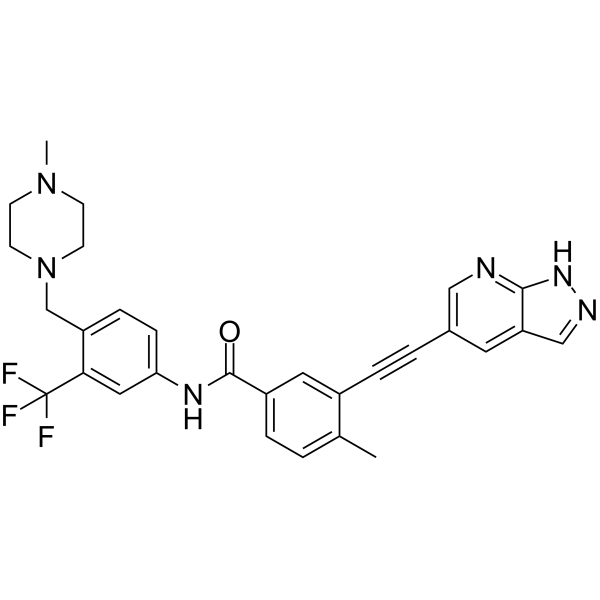All AbMole products are for research use only, cannot be used for human consumption.

In vitro: GZD824 potently inhibits the growth of Ba/F3 cells expressing wildtype Bcr-Abl with IC50 of 1.0 nM. Highly consistent with biochemical kinase inhibition and tight protein binding affinity, GZD824 also strongly inhibits the proliferation of Ba/F3 cells expressing Bcr-AblT315I mutant and 14 other resistance-relevant Bcr-Abl mutants. In addition, GZD824 efficiently suppresses the activation of Bcr-Abl as well as downstream Crkl and STAT5 in a concentration-dependent manner in K562 CML cells.
In vivo: GZD824, at doses of 5 and 10 mg/kg/day, dose-dependently inhibits the tumor growth in the K562 tumor xenograft and the Ku812 xenograft model without mortality or significant body loss. Besides, GZD824 (20 mg/kg/day) suppresses tumor growth in mice bearing allografted Ba/F3 cells expressing Bcr-AblWT and Bcr-AblT315I.
| Cell Experiment | |
|---|---|
| Cell lines | Ba/F3 cells expressing wildtype and mutant Bcr-Abl |
| Preparation method | Cells in the logarithmic phase are plated in 96-well culture dishes. Twenty-four hours later, cells are treated with the corresponding compounds or vehicle control at the indicated concentration for 72 h. CCK-8 is added into the 96-well plates (10 μL/well) and incubated with the cells for 3 h. OD450 and OD650 are determined by a microplate reader. Absorbance rate (A) for each well is calculated as OD450 – OD650. The cell viability rate for each well is calculated as V% = (As – Ac)/(Ab – Ac) × 100%, and the data were further analyzed using Graphpad Prism5. The data are the mean value of the three experiments. As is the absorbance rate of the test compound well, Ac is the absorbance rate of the well without either cell or test compound, and Ab is the absorbance rate of the well with cell and vehicle control. |
| Concentrations | 0-50 μM |
| Incubation time | 72 hours |
| Animal Experiment | |
|---|---|
| Animal models | Mice xenograft or allograft tumor models using K562 and transformed Ba/F3 cells expressing native Bcr-Abl or Bcr-Abl mutants. |
| Formulation | 1% DMSO, 22.5% Cremophor, 7.5% ethanol, and 69% normal saline |
| Dosages | ~20 mg/kg |
| Administration | oral gavage |
| Molecular Weight | 532.56 |
| Formula | C29H27F3N6O |
| CAS Number | 1257628-77-5 |
| Solubility (25°C) | DMSO: 30 mg/mL |
| Storage |
Powder -20°C 3 years ; 4°C 2 years In solvent -80°C 6 months ; -20°C 1 month |
| Related Src-bcr-Abl Products |
|---|
| KX2-361
KX2-361 (KX-02) is a Src-kinase and tubulin polymerization inhibitor. KX2-361 shows anti-tumor activity and induces apoptosis of Glioblastoma (GBM) cell. KX2-361 shows good oral bioavailability and readily crosses the BBB in mice. |
| Risvodetinib
Risvodetinib (IkT-148009) is an orally active, selective and brain-penetrant protein tyrosine kinase inhibitor, displaying excellent target efficacy against c-Abl1, c-Abl2/Arg with IC50 values of 33 nM, 14 nM, respectively. |
| SI-2 hydrochloride
SI-2 hydrochloride is a highly promising SRC-3 inhibitor (PPI) with acceptable oral availability, with IC50 values of 3-20 nM for breast cancer cell death. |
| KB SRC 4
KB SRC 4 is a potent, and highly selective c-Src inhibitor, with a Ki of 44 nM and a Kd of 86 nM, and shows no inhibition on c-Abl up to 125 μM; KB SRC 4 has antitumor activity. |
| Hydroxymethyl dasatinib
Hydroxymethyl dasatinib (M24), a benzylhydroxy metabolite of Dasatinib, exhibits an IC50 of 46.7nM in K562 CML cells. |
All AbMole products are for research use only, cannot be used for human consumption or veterinary use. We do not provide products or services to individuals. Please comply with the intended use and do not use AbMole products for any other purpose.


Products are for research use only. Not for human use. We do not sell to patients.
© Copyright 2010-2024 AbMole BioScience. All Rights Reserved.
